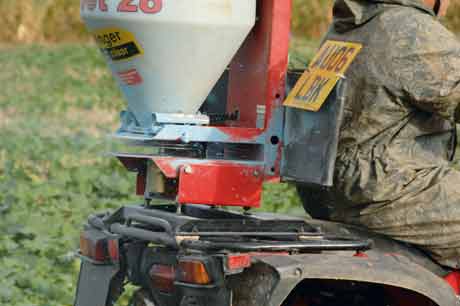New metaldehyde rules force growers to reconsider slug strategy this autumn

Slug pellet formulation is just as important as the active ingredient they contain for effective control of slugs this coming autumn, claims one manufacturer.
Pellets must have good flowability and ballistic properties for even spreading, together with durability, as well as being attractive and palatable to slugs, says Bayer CropScience’s pellet expert Wolfgang Wirth.
“Another requirement is that they are rainfast and resistant to moulding,” he points out. “In most situations, they are being applied to moist soils.”
Three different production processes are used to produce slug pellets, with most manufacturers now using wet extrusion processes, for the better stability they offer, he adds.
“Pellets contain much more than just the active ingredient,” continues Dr Wirth. “They have a silica milling aid, carrier, preservative, dyes, binders and other attractants, such as molasses.”
The carrier should be wheat, he stresses, while the binders vary according to pellet type. Hard wheat flour gives greater pellet stability than soft, helping to make pellets more rainfast and durable, he notes.
Preservative choice is important for moulding resistance, as pellets that develop even slight moulding are less attractive to slugs. Company trials have shown that Draza pellets have more than seven days protection against moulding, he reports.
Bayer’s development manager for molluscicides Richard Meredith believes that pellet type has an important role in the final results in the field.
“We’ve looked at pellet degradation in a range of crops, across different seasons,” he says. “Our wetex pellets have lasted 10-14 days in potatoes, compared to others lasting just one week, while in winter wheat they’ve given an extra one to two weeks protection.”
In oilseed rape, the wetex production process gave an additional three weeks protection, although the trials were done in a relatively dry autumn, admits Dr Meredith.
Attractiveness to slugs also has a bearing, especially after weathering has occurred, he says. “Y-tube comparisons show that slugs are more attracted to methiocarb wetex pellets than they are to metaldehyde-based pellets.”
Slug Species
Most fields contain a mixture of slug species, each with different feeding habits, making their control more difficult than if there was just one present, advises Richard Meredith.
“Unfortunately, they’re not all active at the same time. Some are seen above the ground; others stay beneath the surface, where they feed.”
Favourable conditions for slugs are temperatures between 10-20C, high humidity and a moist soil surface. “So wet summers present an opportunity.
Their growth rate is also temperature dependent – they grow 10 times faster in warmer conditions than cold.”
This year, slugs are on the back foot, after a very cold winter and dry spring. “Their speed of operation and reproduction rate will have been hampered. But never under estimate them,” he warns.
Methiocarb is effective across species, he reports. “It will even take out the Arion species, which can be large and is not well controlled by metaldehyde.”
Pellet application timing is important, especially in potatoes, he advises. “Make the first application when you have 75% crop cover and the slugs are starting to feed. The follow up should be four to five weeks later.”
Soil movements damage slugs, which is why numbers are always low where the plough has been used. “If you’ve ploughed and cultivated, let things settle before you apply pellets.”
Autumn advice
New rules on metaldehyde use will change the way that slug pellets are used, believes Bayer’s Peter Stacey.
The need to target available applications to the crop’s most vulnerable stage will be important, he says, as well as avoiding the use of metaldehyde where there’s a risk of it entering water.
“In oilseed rape, we suggest using metaldehyde up front, at drilling, then switching to methiocarb at the critical germination stage.”
His guidance for winter wheat is to make use of a Deter seed treatment at drilling, before using either methiocarb or metaldehyde at seed swelling and germination.
“After emergence, if you need to make another application, you should use either methiocarb or ferric phosphate, as it may turn wet.”
Slug control costs are likely to rise, he admits. “Using mini metaldehyde pellets costs around £5/ha, whereas Draza pellets are around £20/ha.
“But it’s important to ask whether 210g of metaldehyde will be enough in a high-risk situation, and if you need greater durability and effectiveness in the field.”
The Chemicals Regulation Directorate has set a new legal maximum application rate for metaldehyde. “It brings the legal maximum annual dose for metaldehyde into line with the Metaldehyde Stewardship Group (MSG) guidelines at 700g/ha/calendar year,” explains Anne Fletcher, regulatory spokesperson for the MSG. “Previously there was no set maximum total dose for the active ingredient – in effect meaning that amounts of metaldehyde applied were unlimited,” she explains. East Anglia agronomist Colin Myram highlights that the industry has gone further, with manufacturers withdrawing all products containing more than 700g of metaldehyde per individual application. “And they have gone even further in revising the MSG guidelines that now set a maximum total dose of 210g between the key dates of 1 August to 31 December when the issue of metaldehyde reaching watercourses is at its peak.” Some 38 products have been withdrawn from the market. Chiltern Farm Chemicals is no longer producing its 6% metaldehyde pellets and is concentrating its sales and development effort on the TR Metamax pellets. These contain the company’s patented TR3799 metaldehyde technology, in both 1.5% and 3% pellets which allow farmers to use as little as 3kg/ha (45g ai/ha). Certis has launched a low-dose, low-concentration formulation called MetaPads. Containing 3% metaldehyde, MetaPads have a label rate of 3kg/ha, which delivers 90g of metaldehyde/ha, enough for two applications within the new limits. MetaPads are replacing other pasta based products within the Certis portfolio. Trigger 3 remains on the market for the early pre-August opportunity, while Sluxx is a ferric phosphate-based product for use as an alternative in high risk situations. |
|---|

